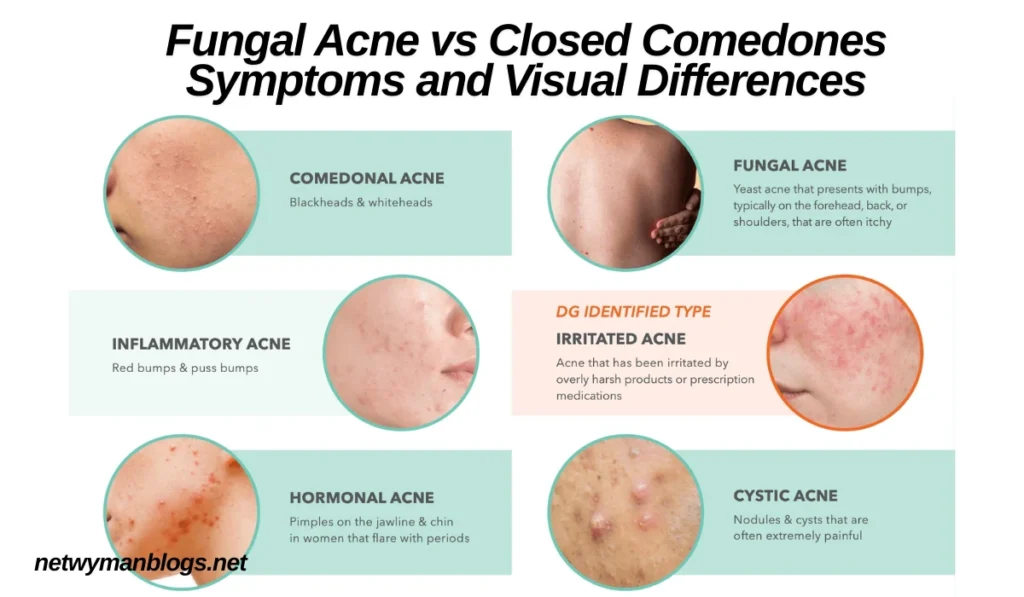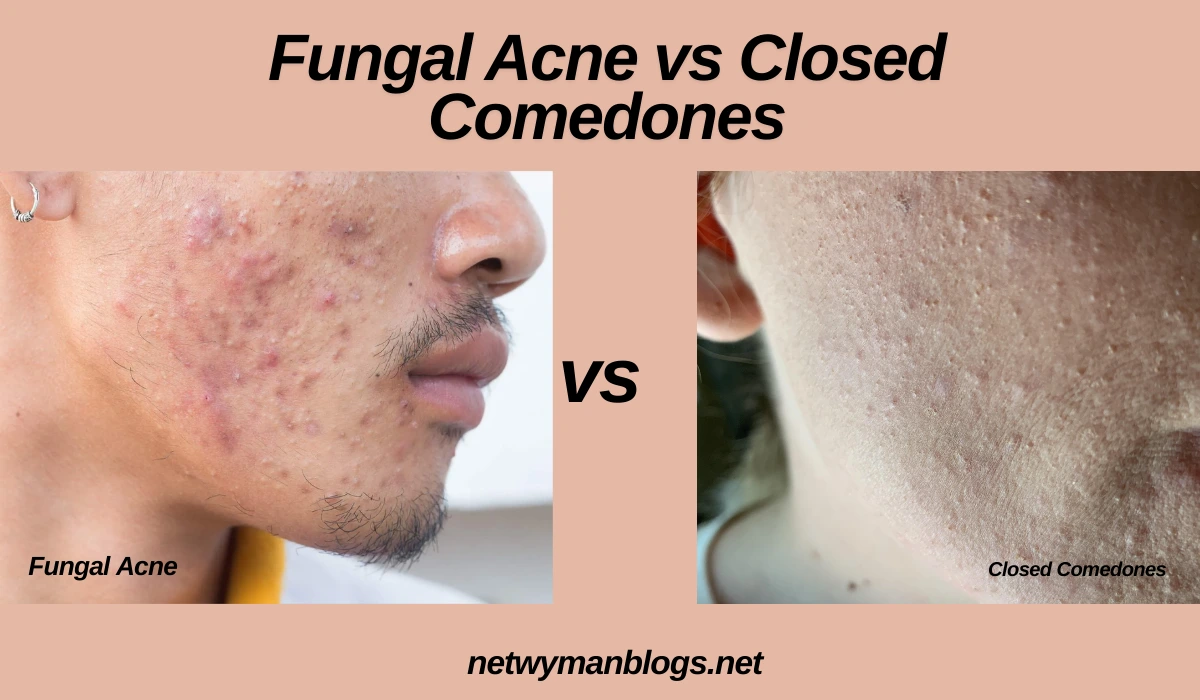When it comes to skin issues, Fungal Acne vs Closed Comedones is a common comparison as they often appear similar, especially to those unfamiliar with their distinctions. Despite their visual similarities, these two skin concerns stem from different causes, and their treatments vary significantly. Let’s break down the differences, causes, symptoms, and treatment options for fungal acne and closed comedones in a clear and detailed way, so you can make informed decisions about your skincare routine.
Understanding Fungal Acne
Fungal acne is technically not acne in the traditional sense. Instead, it’s a skin condition caused by an overgrowth of yeast known as Malassezia, which lives on the skin. Fungal acne is medically called Malassezia folliculitis or Pityrosporum folliculitis and often appears in clusters of small, itchy red bumps that are similar in size and can look like acne. This condition can easily be mistaken for bacterial acne, but fungal acne has a very distinct cause.
Fungal acne thrives in warm and humid environments. People with oily skin or frequently sweat due to activities or weather conditions are more prone to fungal acne. Factors like tight clothing, hot climates, and inadequate skin hygiene after sweating can also contribute to fungal acne flare-ups.
The most common areas for fungal acne include the forehead, cheeks, upper back, chest, and neck. These areas tend to trap sweat and oils, providing an ideal breeding ground for yeast. Unlike bacterial acne, fungal acne does not respond well to traditional acne treatments, as it is driven by yeast rather than bacteria.
Read more: Tbg95
Recognizing Closed Comedones
Closed comedones, commonly known as whiteheads, are a type of non-inflammatory acne caused by the blockage of skin pores by dead skin cells, oil, and sometimes bacteria. This blockage prevents the material from being exposed to air, hence the term “closed.” Closed comedones are typically flesh-colored or white, small bumps that are smooth to the touch. They do not usually have the red, inflamed appearance that traditional acne or fungal acne might have.
Closed comedones often appear on the forehead, cheeks, chin, and T-zone—areas with higher oil production. While closed comedones are not itchy or painful like fungal acne, they can persist for long periods and may worsen over time if not treated correctly. Excessive use of oily skincare products, poor cleansing habits, and hormonal fluctuations can contribute to their formation.
In summary, closed comedones are a result of clogged pores, whereas fungal acne results from an overgrowth of yeast in hair follicles. Their similarities in appearance can make them difficult to distinguish without careful observation or consultation with a dermatologist.
Causes of Fungal Acne vs Closed Comedones
The causes of fungal acne and closed comedones differ fundamentally. Understanding these causes can help you identify the best treatment approach for each.
- Yeast Overgrowth: Fungal acne is triggered by an overgrowth of the Malassezia yeast in hair follicles. Often exacerbated by sweaty, warm conditions.
- Poor Hygiene: Fungal acne is more likely to develop if sweat and oils aren’t cleansed properly from the skin after exercise or exposure to heat.
- Weakened Immune System: A compromised immune system can make you more susceptible to fungal infections, including fungal acne.
- Environmental Factors: Hot and humid environments increase the risk of yeast overgrowth. This is why fungal acne is often more prevalent in tropical climates.
- Excess Oil Production: Hormones, genetics, and skincare routines can increase oil production. Which mixes with dead skin cells to clog pores.
- Skincare Products: Comedogenic, or pore-clogging, ingredients in makeup and skincare products can block pores and lead to closed comedones.
- Poor Cleansing Habits: Inadequate cleansing can lead to dead skin cells and oil buildup. Which contributes to clogged pores.
- Hormonal Imbalances: Hormonal changes, especially during puberty or menstrual cycles, can increase oil production, making the skin more susceptible to comedones.
Fungal Acne vs Closed Comedones Symptoms and Visual Differences

While both fungal acne and closed comedones present small, uniform bumps on the skin, there are key differences in symptoms and appearance.
| Aspect | Fungal Acne | Closed Comedones |
|---|---|---|
| Cause | Yeast overgrowth (Malassezia) | Blocked pores from oil and dead skin cells |
| Appearance | Small, red, uniform bumps, often in clusters | Flesh-colored or white bumps |
| Itchiness | Often itchy, sometimes with a stinging sensation | Usually not itchy |
| Common Areas | Forehead, cheeks, back, chest | Forehead, chin, T-zone |
How to Treat Fungal Acne vs Closed Comedones
When it comes to treatment, recognizing the difference between fungal acne vs closed comedones is crucial. Treating one as if it were the other could worsen the condition. Here’s a look at the best treatment options for each.
Fungal Acne Treatment
Fungal acne requires treatments that target yeast rather than bacteria. For mild cases, topical antifungal creams containing ingredients like ketoconazole or clotrimazole can help reduce yeast overgrowth. For more persistent cases, dermatologists may recommend oral antifungals such as fluconazole. A simple and effective way to manage fungal acne is to shower after sweating and wear breathable, loose clothing to reduce skin chafing.
For skincare, opt for products labeled non-comedogenic and antifungal. Using traditional acne products like salicylic acid or benzoyl peroxide can worsen fungal acne, so it’s essential to avoid these.
Closed Comedone Treatment
Closed comedones respond well to skincare products designed to clear pores and reduce oil production. Salicylic acid, glycolic acid, and retinoids are highly effective in treating closed comedones by exfoliating the skin and helping to unclog pores. Regularly cleansing the skin with a gentle cleanser and avoiding heavy, oil-based products can also prevent the formation of new comedones.
In some cases, dermatologists may recommend prescription retinoids or other treatments such as chemical peels to improve skin texture and clarity. These treatments help to reduce pore congestion and allow for more effective removal of comedones.
Read more: Miami heat vs Boston Celtics match player stats
Fungal Acne vs Closed Comedones
Here’s a quick summary to distinguish fungal acne from closed comedones effectively.
| Feature | Fungal Acne | Closed Comedones |
|---|---|---|
| Caused by | Yeast (Malassezia overgrowth) | Clogged pores (oil, dead skin cells) |
| Appearance | Uniform, itchy bumps in clusters | Small, flesh-colored, or white bumps |
| Treatment Focus | Antifungal medications | Exfoliating products like salicylic acid |
| Common Affected Areas | Forehead, back, chest | T-zone, chin, cheeks |
| Triggers | Humidity, sweating, tight clothing | Hormonal changes, pore-clogging products |
Frequently Asked Question
How can I tell if I have fungal acne or closed comedones?
Fungal acne usually appears as clusters of itchy, red bumps and often worsens in humid conditions, while closed comedones are small, flesh-colored bumps that do not itch.
Can closed comedones turn into acne?
Yes, if closed comedones become irritated or infected, they can develop into inflamed acne lesions.
Are antifungal shampoos helpful for fungal acne?
Yes, antifungal shampoos with ingredients like ketoconazole can be used on the body to help manage fungal acne.
Should I avoid oily skincare products if I have closed comedones?
Yes, using non-comedogenic products can help prevent the clogging of pores and the formation of new closed comedones.
Conclusion
While both fungal acne and closed comedones can be visually similar, understanding the fundamental differences between Fungal Acne vs Closed Comedones is key to effective treatment. Fungal acne is caused by an overgrowth of yeast in hair follicles. Thrives in humid environments, and typically presents as itchy, uniform red bumps. Closed comedones, or whiteheads, result from clogged pores due to oil, and dead skin cells. Skincare products, and they present small, flesh-colored bumps.
Treating fungal acne requires antifungal medications, while closed comedones benefit from exfoliating treatments like salicylic acid and retinoids.
Consulting a dermatologist is always a good idea if you’re unsure which condition you have, as professional advice can prevent ineffective treatments and offer faster relief.

